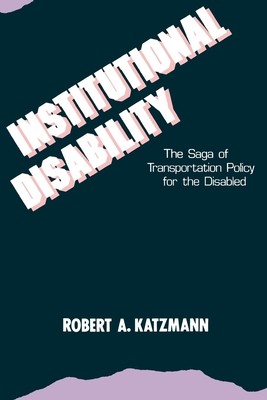
- We will send in 10–14 business days.
- Author: Robert A Katzmann
- Publisher: Brookings Institution Press
- ISBN-10: 0815748337
- ISBN-13: 9780815748335
- Format: 15.2 x 22.9 x 1.3 cm, softcover
- Language: English
- SAVE -10% with code: EXTRA
Reviews
Description
This case study of transportation policy for disabled people illustrates the flaws in policymaking that lead many Americans to believe government is not working as it should. Robert A. Katzmann examines the workings of the legislative, administrative, and judicial processes, both separately and in interaction, as he relates the erratic path of transportation policy for the disabled over two decades. An estimated 13.4 million people in this country have difficulty using public transportation, but the federal response to their problems of mobility is of fairly recent vintage, beginning with legislation in the early 1970s. Since then, there have been many twists and turns in policy, involving a wide array of governmental institutions. These constant shifts have confused state and local governments, the transit industry, and the disabled community. Assessing why policy was so erratic, Katzmann concludes that in part the confusion resulted from the inability to choose between conflicting approaches to the problem--one oriented toward the rights of equal access for the disabled, and the other favoring effective mobility by any practical means. In addition, the conflict between these two policy approaches was compounded by increasing fragmentation within and among national institutions.
EXTRA 10 % discount with code: EXTRA
The promotion ends in 18d.18:38:50
The discount code is valid when purchasing from 10 €. Discounts do not stack.
- Author: Robert A Katzmann
- Publisher: Brookings Institution Press
- ISBN-10: 0815748337
- ISBN-13: 9780815748335
- Format: 15.2 x 22.9 x 1.3 cm, softcover
- Language: English English
This case study of transportation policy for disabled people illustrates the flaws in policymaking that lead many Americans to believe government is not working as it should. Robert A. Katzmann examines the workings of the legislative, administrative, and judicial processes, both separately and in interaction, as he relates the erratic path of transportation policy for the disabled over two decades. An estimated 13.4 million people in this country have difficulty using public transportation, but the federal response to their problems of mobility is of fairly recent vintage, beginning with legislation in the early 1970s. Since then, there have been many twists and turns in policy, involving a wide array of governmental institutions. These constant shifts have confused state and local governments, the transit industry, and the disabled community. Assessing why policy was so erratic, Katzmann concludes that in part the confusion resulted from the inability to choose between conflicting approaches to the problem--one oriented toward the rights of equal access for the disabled, and the other favoring effective mobility by any practical means. In addition, the conflict between these two policy approaches was compounded by increasing fragmentation within and among national institutions.


Reviews